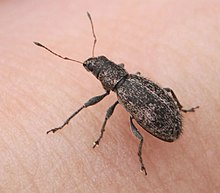Polydrusus inustus
| Polydrusus inustus | ||||||||||||
|---|---|---|---|---|---|---|---|---|---|---|---|---|

Polydrusus inustus |
||||||||||||
| Systematics | ||||||||||||
|
||||||||||||
| Scientific name | ||||||||||||
| Polydrusus inustus | ||||||||||||
| Germar , 1824 |
Polydrusus inustus is a beetle from the family of weevils (Curculionidae).
features
The beetles are 3.5–5.5 mm long. The elytra are covered with elongated gray, mostly copper-shimmering scales. These usually form spots or longitudinal stripes on the wing covers . The wing covers have long, dense and dark protruding bristles. The trunk is very short and very flat at the top. The relatively large eyes are strongly arched. The label is small and bare. The antennae , femora and tibiae are black, while the tarsi and the remainder of the antennae are red-brown in color. The femora have small, sharp teeth.
distribution
The beetle species is common in the Palearctic . Its main area of distribution is in the Pontic region. Their occurrence extends across Asia Minor to the Middle East . In Europe, the species spread westward in the 20th century. In 1956 the western limit of distribution was still near Posen in Poland . In 1972 the species reached France via Germany. The first discovery in Alsace, near Strasbourg, was not made until 1996, in Baden-Württemberg, near Kehl, in 2005; since then a number of new finds from the Rhine valley have been found here. It is assumed that the way of distribution is spread by humans (the species has shortened hind wings and is unable to fly).
Way of life
The beetle species is very polyphagous , which means that it uses a wide range of food and host plants. In addition to hardwoods (sloe, apple, oak, elm), blackberries and herbaceous species, mostly butterflies, are also given. As far as is known, the larvae live on roots. The adult beetles are observed from April to August. As with the related species, it is believed that the larva overwinters and pupates in spring.
Individual evidence
- ↑ a b c Arved Lompe: Beetle of Europe - Polydrusus . www.coleonet.de. Retrieved August 27, 2019.
- ↑ a b c d e f g h i Heinz Freude , Karl Wilhelm Harde , Gustav Adolf Lohse (ed.): Die Käfer Mitteleuropas . tape 10 : Bruchidae – Curculionidae 1 . Goecke & Evers , Krefeld 1981, ISBN 3-87263-029-6 , pp. 245, 246 .
- ↑ Polydrusus (Scythodrusus) inustus in Fauna Europaea. Retrieved August 27, 2019
- ^ A b Joachim Rheinheimer: The weevils of Baden-Württemberg. published by the LUBW State Institute for the Environment, Measurements and Nature Conservation Baden-Württemberg, Karlsruhe 2010. ISBN 978-3-89735-608-5 , pp. 367–368.
Web links
- Polydrusus inustus at www.biolib.cz
- www.kerbtier.de

